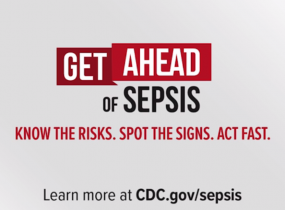Basic Information
What is sepsis?
Sepsis is the body’s extreme response to an infection. It is life-threatening, and without the timely treatment, sepsis can rapidly cause tissue damage, organ failure, and death.
Sepsis happens when an infection you already have – in your skin, lungs, urinary tract or somewhere else – triggers a chain reaction throughout your body.
What causes sepsis?
Four types of infections that are often linked with sepsis are:
- lungs (pneumonia)
- kidney (urinary tract infection)
- skin
- gut
The most frequently identified germs that cause infections that develop into sepsis include:
- Staphylococcus aureus (staph)
- Escherichia coli (E. coli)
- some types of Streptococcus
What is the difference between an infection and sepsis?
An INFECTION occurs when germs enter a person’s body and multiply, causing illness, organ and tissue damage, or disease.
If that infection isn’t stopped, it can cause a life-threatening condition called SEPSIS.
Who is at risk?
Anyone can get an infection, and almost any infection can lead to sepsis. Certain people are at higher risk:
- Adults 65 or older.
- People with chronic medical conditions, such as diabetes, lung disease, cancer, and kidney disease
- People with weakened immune systems
- Children younger than one
How can I get ahead of sepsis?
- Talk to your doctor or nurse about steps you can take to prevent infections. Some steps include taking good care of chronic conditions and getting recommended vaccines.
- Know the symptoms of sepsis.
- Practice good hygiene, such as handwashing, and keeping cuts clean until healed.
- ACT FAST. Get medical care IMMEDIATELY when an infection is not getting better or if it gets worse.
Always remember, sepsis is a medical emergency. Time matters. If you or your loved one suspects sepsis or has an infection that’s not getting better or is getting worse, ask your doctor or nurse, “Could this infection be leading to sepsis?”
What are the symptoms?
There is no single symptom of sepsis.
Symptoms of sepsis can include a combination of any of the following:
- Confusion or disorientation
- Shortness of breath
- High heart rate
- Fever, or shivering, or feeling very cold
- Extreme pain or discomfort
- Clammy or sweaty skin
Get medical help immediately if you suspect sepsis, or if your infection is not getting better or is getting worse.
I think I may have sepsis. What should I do?
Sepsis is a medical emergency. Time matters. Call your doctor or go to the emergency room immediately if you suspect sepsis.
- It’s important that you ask, “Could this be sepsis?”
- If you are continuing to feel worse or not getting better in the days after surgery, ask your doctor about sepsis.
- If you have an infection and don’t get better or start feeling worse, ask your doctor, “Could this infection be leading to sepsis?”
How is it diagnosed?
More Information
- International Sepsis forum: Promoting a better understanding of Sepsis [PDF – 254 KB]·
- Journal of the American Medical Association Patient Page [PDF – 339 KB]
- Mayo Clinic Diseases and Conditions: Sepsis Overview
- Children’s Hospital Association: Sepsis Overview
- National Institutes of Health MedlinePlus topic: Sepsis Overview
Doctors diagnose sepsis using a number of physical findings like fever, low blood pressure, increased heart rate, and increased breathing rate. They also do lab tests that check for signs of infection and organ damage.
Many of the symptoms of sepsis, such as fever and difficulty breathing, are the same as in other conditions, making sepsis hard to diagnose in its early stages.
What is the treatment?
People with sepsis are treated in the hospital. Research shows that rapid, effective sepsis treatment, which includes giving antibiotics, maintaining blood flow to organs, and treating the source of infection, can save lives.
Doctors treat sepsis with antibiotics as soon as possible. Many patients receive oxygen and intravenous (IV) fluids to maintain blood flow and oxygen to organs. Other types of treatment, such as assisting breathing with a machine or kidney dialysis, may be necessary. Sometimes surgery is required to remove tissue damaged by the infection.
Importance of Recognizing Sepsis
Stories from people who survived sepsis and from the families of people who did not survive.
- My Story: When the Signs of Sepsis are Missed
- A Family’s Perspective – “The Brutality of Sepsis will Haunt Us for the Rest of Our Lives”
- The Need for Sepsis Awareness: A Survivor’s Perspective
Advocacy Organizations
Rory Staunton Foundation for Sepsis Prevention
Supports education and outreach efforts aimed at rapid diagnosis and treatment of sepsis, particularly in children.
Sepsis Alliance®
Created to raise sepsis awareness among both the general public and healthcare professionals. Sepsis Alliance offers information on a variety of sepsis-related topics.
Educational Campaigns and Awareness Dates
- Page last reviewed: September 16, 2016
- Page last updated: August 25, 2017
- Content source:


 ShareCompartir
ShareCompartir
